Tuesday Jan 13, 2026
Tuesday Jan 13, 2026
Wednesday, 2 August 2023 00:30 - - {{hitsCtrl.values.hits}}
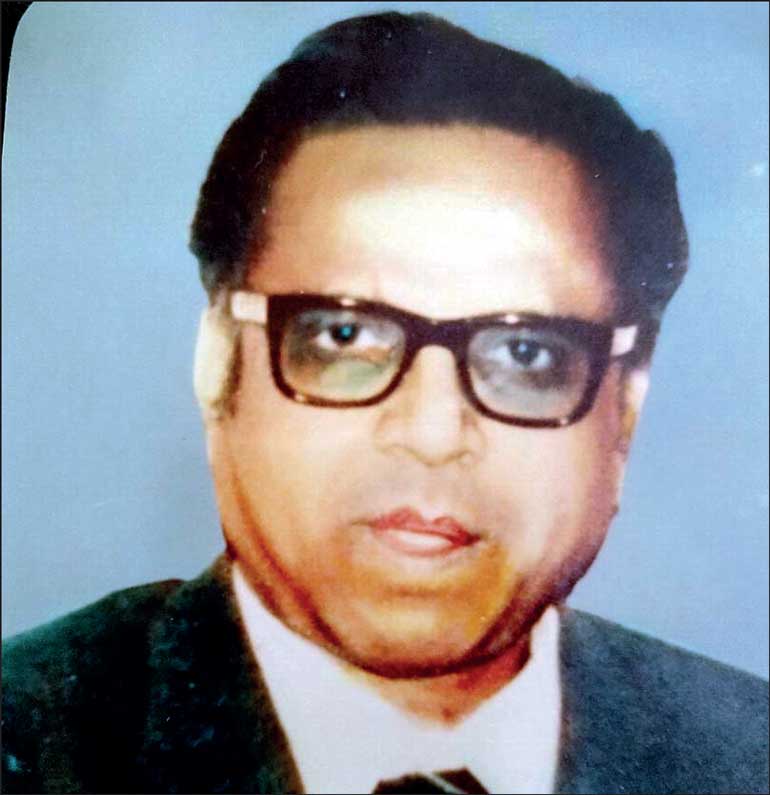
Kandiah Kanthasamy
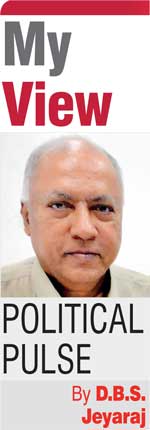 The political struggle of the Sri Lankan Tamils to have their grievances redressed and lost rights restored has brought forth many “quiet” heroes. I say quiet because these persons never sought publicity or praise. They gave up their comfortable existence and served their community in many ways. Many of them refused to kowtow before authoritative Governments as well as autocratic armed groups. Some of them paid the supreme price for their courageous defiance. Sadly the sacrificial contributions made by such people is unacknowledged and even forgotten. This week’s column focuses on such a person.
The political struggle of the Sri Lankan Tamils to have their grievances redressed and lost rights restored has brought forth many “quiet” heroes. I say quiet because these persons never sought publicity or praise. They gave up their comfortable existence and served their community in many ways. Many of them refused to kowtow before authoritative Governments as well as autocratic armed groups. Some of them paid the supreme price for their courageous defiance. Sadly the sacrificial contributions made by such people is unacknowledged and even forgotten. This week’s column focuses on such a person.
Kandiah Kanthasamy was a Jaffna-born lawyer who enjoyed a lucrative practice in Colombo. Yet he turned his life around by transforming himself into a human rights lawyer and human rights activist. He also dedicated himself to a life of service that attempted in many ways to alleviate the suffering of thousands of Tamils displaced by the anti-Tamil violence of 1977, 1981 and 1983 and during the military conflict in the North and East of Sri Lanka. Kanthasamy also strove in multiple ways to highlight the racist discrimination and human rights violations targeting Tamils and draw international attention.
Among the many organisations and institutions he set up or played a key role in setting up were the Tamil Refugees Rehabilitation Organisation (Colombo, later Jaffna), Central British Fund For Tamil Refugees nation (UK); Theepan Research Institute (Jaffna); New Era Publication Ltd., publishers of Saturday Review of (Jaffna), Home For Human Rights (Jaffna), Tamil Information Centre (UK) Tamil Information Centre, later Tamil Information and Research Unit (Madras), Tamil Information Centre (Madurai); Movement For Integration Of Refugees and Repatriates (Madurai). He was also engaged in the process of establishing in Jaffna an institute for Communication Research and another Institute Development Research when he was abducted and killed by the Tamil militant group Eelam Revolutionary Organization (EROS). The 35th anniversary of his demise was observed last June.
Why then did the EROS abduct and kill Kanthasamy, a man who did so much for the Tamil people? Likewise why did Tamil militant groups at different times kill so many Tamils who served the Tamil people to the best of their ability? The standard answer to these questions is – the wrong course adopted by those involved in the Tamil armed struggle!
Personal relationship
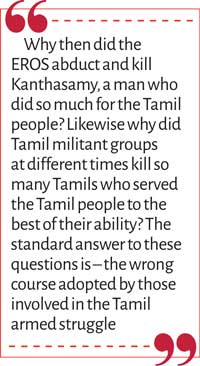 Before writing in detail about the life of Kanthasamy and his positive, constructive contribution to the welfare and betterment of the Tamil people, I wish to place on record my personal relationship with Kantha as he was generally known. However I used to call him Kantha Annan or elder brother.
Before writing in detail about the life of Kanthasamy and his positive, constructive contribution to the welfare and betterment of the Tamil people, I wish to place on record my personal relationship with Kantha as he was generally known. However I used to call him Kantha Annan or elder brother.
In those days the Tamil United Liberation Front (TULF) Colombo branch used to hold a weekly meeting every Wednesday that was open to the public. It was at these meetings that I first met Kanthsamy and became acquainted with him. I was not a journalist then.
I became a journalist in 1977 by joining the “Virakesari” as a Staff Reporter. Thereafter Kanthasamy interacted with me more frequently discussing politics and current affairs. The first lead story written by me for the “Virakesari” was due to a tip-off given by Kantha. The August 1977 anti-Tamil violence brought us closer as I did some volunteer work for the Tamil Refugee Rehabilitation Organization (TRRO) that he was instrumental in setting up.
Our friendship or rather a fraternal type of association grew over the years until he went off to London in order to avoid possible arrest. However we remained in contact. In 1988 he returned to Sri Lanka and we met frequently when he was in Colombo. In June 1988, Kantha was abducted by the EROS and made to “disappear”.
A few months later I left Sri Lanka for the USA and then moved to Canada in 1989. I got married in 1992 to Kanthasamy’s niece – his sister’s daughter. But Kanthasamy was not alive to see his “Thamby” like friend become a family member.
Maaviddapuram
Kandiah Kanthasamy was born on 6 April 1930, the son of a school teacher. Hailing from Maaviddapuram in Valikamam north, he had his education at Jaffna Hindu College and St. John’s College. He entered university and obtained a degree specialised in mathematics. After a brief spell of teaching, Kantha went on to do law. He excelled in commercial and company law and built up a lucrative practice on those lines. Although keeping a low profile among legal luminaries, Kanthasamy commanded a very high income at that time.
TRRO
The 1977 August anti-Tamil violence was in a sense the watershed that changed life for Kanthasamy. As he himself stated later, “To be a Tamil was one of the greatest misfortunes in August September 1977.” Kantha was one of the founding fathers of the Tamil Refugees Rehabilitation Organisation (TRRO). This organisation did yeoman service in providing refuge, relief, rehabilitation and resettlement to the thousands displaced by violence. J.R. Jayewardene insisted that the organisation remove the word Tamil if approved charity status was to be bestowed.
Kanthasamy and President, TRRO, K.C. Nithyananda, quite rightly refused. Yet the social fabric of the Tamils along with international non-governmental assistance was enough to launch very worthwhile projects. So successful was the TRRO then that a campaign of covert and overt repression with the unofficial sanction of the State was unleashed against it.
Sansoni Commission
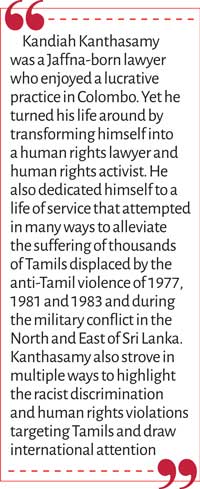 When the Government appointed former Chief Justice M.E.C. Sansoni to probe the 1977 violence, Kanthasamy plunged himself with full zeal into the proceedings of the Sansoni Commission. Once again his role was not that of the stridently articulate courtroom advocate but more of the silently instructive proctor of old. He was the livewire behind the elaborate legal preparations undertaken on behalf of victimised Tamils.
When the Government appointed former Chief Justice M.E.C. Sansoni to probe the 1977 violence, Kanthasamy plunged himself with full zeal into the proceedings of the Sansoni Commission. Once again his role was not that of the stridently articulate courtroom advocate but more of the silently instructive proctor of old. He was the livewire behind the elaborate legal preparations undertaken on behalf of victimised Tamils.
Kanthasamy was also instrumental in publishing the Sansoni Commission Evidence in English that helped spotlight the atrocities of 1977. When the commission began sitting in Jaffna in 1978, a galaxy of 24 Tamil lawyers were present, one of whom was Kanthasamy. He was the only Tamil lawyer to see it right through to the end, thereby severely damaging his law practice.
Saturday Review
Realising that an English journal was necessary, Kanthasamy and three of his friends formulated plans for the publication of Saturday Review with the primary objective of inseminating correct information on events and developments in Sri Lanka and outside. The weekly paper was meant to analyse events and trends and interpret them against the background in which they occurred.
Above all it was aimed to meet the challenge of establishing two-way communication between all peoples and nationalities in the country, and in the process to serve as a vehicle for building healthy and civilised interaction, and as a useful link between Sri Lanka and its people abroad. In particular it would reflect the ethos and life around the area from which it was to be published (i.e. Jaffna) with authenticity. Finally Saturday Review was to be an independent non-partisan journal offering its columns for free comment and the expression of views within the limits of law and reason.
Though Kanthasamy arranged for the finances and set up the organisational structure of the Saturday Review, he never interfered in editorial and management functions. Those entrusted with these responsibilities however did not adhere faithfully to the original objectives behind the launching of the review. As a result the paper adopted an abrasive style that created needless controversy particularly within the Tamil community. At the same time the efficiency of managerial persons too was very much wanting.
As a result the paper never realised its full potential but produced many enemies for Kanthasamy. As he himself observed: “Dale Carnegie wrote a lot about how to win friends and influence people. I know the secret to lose friends and make enemies and that is to publish an independent paper.”
Britain
In 1983 prior to “Black July” the political grapevine began buzzing that Kanthasamy was going to be arrested under the PTA by the Jayewardene regime. Kanthasamy’s coronary condition too was not very healthy. So he left the country for Britain. Then came the July ‘83 holocaust.
A shocked Kanthasamy’s condition deteriorated and he was soon hospitalised in London. Upon recovery, the man seemed to get his second wind. He immersed himself with indefatigable energy and total dedication into service for humanity again. Using his personal charm to collective advantage, Kanthasamy cultivated various aid-giving agencies to garner a large amount of funds. This was channelled into numerous projects.
Apart from continuous assistance to the TRRO and Saturday Review, there was the Central British Fund for Tamil Refugee Rehabilitation, the Theepam Research Institute, the Home For Human Rights Centre in Jaffna. The Tamil information centres of London, Madras and Madurai, the Tamil Information and Research Unit of Madras, and the Movement for Integration of Refugees and Repatriates of India.
Return
After the 1987 Indo-Lanka accord, Kanthasamy wound up all his overseas activity and returned to Sri Lanka in January 1988. He naively assumed that real peace had set in. He also wanted to return to Jaffna and base himself there. When I cautioned him about it in Colombo, Kanthasamy replied with a smile, “Already I’m after by pass surgery. I have only a few more years to live. Let me die in Jaffna.” How woefully prophetic those words were.
Upon returning to Jaffna Kanthasamy found that the internal affairs of some institutions he had founded, fostered, nurtured and nourished were not very satisfactory. An existential reality of Jaffna life in the post ‘83 period was that of the dominance of so-called Tamil militants in every sphere of life. The gun culture was the ruling ideology, Kantha living in London for five years had not fully realised the transformation of society in Jaffna.
One of the things he could not stomach was the compromising of independence by the TRRO. It was apparently taking instructions from the Tamil armed groups. Another irritant was the allegedly improper handling of finances involving certain projects.
Eelam Revolutionary Organisation
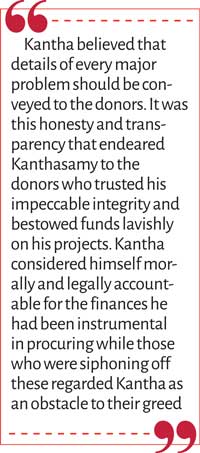 Kantha’s honest and principled approach to public affairs necessitated his adopting a firm stance against these practices. This in turn incurred the wrath of the Tamil armed groups and also provoked some of those within the TRRO itself. The Eelam Revolutionary Organisation known as EROS too had its refugee organisation called the Eelam Refugee Organisation. EROS had always been interested in controlling all aspects of refugee rehabilitation in the Tamil region. Earlier it had killed Kathiramalai, a refugee rehabilitation official of the Sarvodaya movement, heaping wild charges against him.
Kantha’s honest and principled approach to public affairs necessitated his adopting a firm stance against these practices. This in turn incurred the wrath of the Tamil armed groups and also provoked some of those within the TRRO itself. The Eelam Revolutionary Organisation known as EROS too had its refugee organisation called the Eelam Refugee Organisation. EROS had always been interested in controlling all aspects of refugee rehabilitation in the Tamil region. Earlier it had killed Kathiramalai, a refugee rehabilitation official of the Sarvodaya movement, heaping wild charges against him.
Soon the EROS began getting irritated by Kanthasamy. EROS may also have been encouraged by corrupt employees of the TRRO who were troubled by Kantha’s strict adherence to financial discipline and accountability. Balakumar, the joint leader of the EROS then met Kanthasamy and discussed matters amicably at the beginning. The EROS in Trincomalee had set up a front organisation – Trincomalee District Development Foundation. It was also contemplated to set up one on similar lines in Jaffna. The idea was to encompass all refugee organisations under one umbrella controlled by the EROS. Kanthasamy refused to go along with this idea. The ulterior motive of the EROS was to misappropriate large portions of refugee funds for their outfit.
With frank forthrightness Kantha made it known that he would not budget. He would also inform all donor agencies of the reality of the situation. Kantha believed that details of every major problem should be conveyed to the donors. It was this honesty and transparency that endeared Kanthasamy to the donors who trusted his impeccable integrity and bestowed funds lavishly on his projects. Kantha considered himself morally and legally accountable for the finances he had been instrumental in procuring while those who were siphoning off these regarded Kantha as an obstacle to their greed.
Kanthasamy also had a fierce sense of independence. He was of the view that the TRRO should not tolerate political interference by the EROS and said publicly, “If we cannot carry on as a free organisation we should close it (TRRO) down.” These sentiments too were rapidly conveyed to the EROS by the moles within the TRRO.
EROS confrontation
The EROS directly confronted Kanthasamy. An excerpt from a note prepared by Kanthasamy and sent to trusted friends described what happened. “Three people came and said that they were from EROS and wanted to meet me. They said that I could not trifle with an organisation like EROS and that they would send me a van the following morning at 11 am and that I should come to their office.”
“However, the following morning the three of them (Ravi, Vasanthan and Andrew Joseph) came at 11.30 am and there was no suggestion that I should go to their office. The discussion was centered on the memorandum circulated by TRRO under my signature. They said they would disrupt any rehabilitation work not in conformity with their policy, and no work would be tolerated except with their permission (as an afterthought they added “with the permission of LTTE”). When I asked them what their policy was, they said they could not announce it, but permission should be obtained case by case.”
“They also reminded me that Kathiramalai was killed because he acted against the policy of EROS, and that could be the fate of others as well. The meeting was not as tough as it was the previous day, but was possibly intended to be intimidatory. I later learned in Trincomalee that it was a “warning.”
Matters came to a head when the EROS summoned then Chairman, TRRO, Prof. K. Sivathamby and ordered him to issue a statement publicly stating that Kanthasamy had nothing to do with the TRRO. Balakumar of the EROS was in a foul mood and refused to even discuss the issue. Later Secretary, TRRO, Aravinthan too was called by Balakumar and informed that Kanthasamy should go. Some TRRO personnel warned Kanthasamy that his life may be in danger. Well-wishers of Kanthasamy within the community urged him to escape to Colombo and lie low for a while. Kanthasamy refused, saying he would not run away.
White van abduction
On 19 June 1988, a white van of EROS came to Kanthasamy’s temporary residence in Jaffna in the morning. He was seen being bundled in by three men. That was the last anyone saw of him. A huge outcry was raised by concerned individuals and groups both nationally and internationally. The EROS was under great pressure.
The experience of Dr. Brian Seneviratne from Australia is significant. In his own words, “I was abroad when Kanthasamy was abducted and did not hear of it for some time. As soon as I heard about it, I telephoned a senior member of EROS in London and asked him about the abduction. He launched into a tirade against Kanthasamy. The basic problem, he said, was that “We are Marxists and he is not.” When asked whether that was sufficient reason for abduction, he replied that their group did not abduct Kanthasamy but told me that I should not expect to see him alive.”
Paasarai Iyakkam
With mounting international condemnation of the abduction, the EROS did a complete somersault and issued a statement praising Kanthasamy and all the work he had done. The EROS after issuing a statement denying involvement and praising Kanthasamy did something else. They got the Murasoli newspaper in Jaffna, to publish a statement purportedly issued by a hitherto unheard-of group, the Pasarai Iyakkam.
The statement said, “The disappearance of Kanthasamy of the TRRO is only a starting point in our action to eliminate the destructive elements which have penetrated into all spheres of the society. We would like to inform those who are looking for Kanthasamy that he cannot be found at any time in this birth.”
Later Balakumar told a close associate of Kanthasamy in confidence that they had not killed Kantha but he had suffered a heart attack when they were questioning him harshly on the night of June 19 itself. They did not know how to react and had clandestinely cremated Kantha, Balakumar reportedly said.
Balakumar-Shankar Rajee
But the tale told by an Indian army officer to a close associate of Kantha was different. According to this official, the Indian Intelligence had monitored a call between EROS Co-leader Shankar Rajee in India and Balakumar in Jaffna when Rajee had concurred with Balakumar that Kantha should be killed. The IPKF then launched a search of EROS camps and safehouses but could not trace Kantha.
Subsequently a high profile EROS member revealed to Indian authorities that Kantha had been killed, chopped into pieces and dumped in a latrine sewer. What a gruesome end of a truly noble soul!
Epitaph
A fitting epitaph to Kantha and a prophetic indictment of contemporary Tamil politics is available in an excerpt from a letter written by British writer David Selbourne after Kantha’s abduction to Suriya Wickremesinhe, a dear friend of Kantha and a human rights activist colleague.
“The disappearance and probable death of poor Kanthasamy has afflicted me like no other horror of the Lankan Disaster. He was one of the very best and most honest of men, equal to twenty of your Prabhakarans and other such tinpot heroes, who are leading the Tamils towards a long term political and moral disaster, which the present savagery of the conflict, and the resolutions of support from this or that useless conference, prevent them from seeing.”
(The writer can be reached at [email protected].)